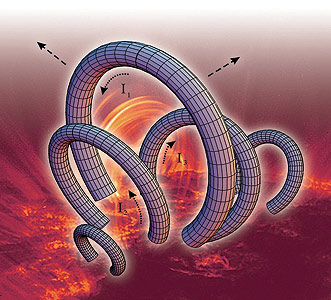The studies in the field of physics of solar plasma have been recently focused on the development of the theory explaining the origin of various components of the Sun's electromagnetic emission, solution of the problem of heating of the solar corona, mechanisms of particle acceleration in solar flares, as well as on the analysis of the structure and dynamics of active regions in the corona and the development of the kinetic theory of the solar wind (V. V. Zheleznyakov,
V. V. Zaitsev, E. Ya. Zlotnik, and V. M. Gubchenko).
| |
 |
| |
Coronal magnetic loops containing high (up to 1011 A)
electric current generated by photospheric convection
|
The most important achievements in these fields are:
- determination of the decisive role of the double plasma resonance in the origin of several components of the sporadic radio emission of the Sun including the zebra structure and the abnormal structure of dynamic spectra of the Type III bursts. The model based on the action of the double plasma resonance under the Sun's conditions has been recently confirmed in direct observations of the coronal positions occupied by sources of various stripes in the zebra structure;
- finding of the parametric resonance between five-minute oscillations in the photospheric-convection rate and natural acoustic oscillations of the coronal magnetic loops, which gives evidence of the penetration of powerful energy flows from the photosphere to the corona, and development on this basis of the mechanism of plasma heating in coronal magnetic loops;
- development of the concept of flare energy release, which is based on the found effect of a sharp increase in the electric current in coronal magnetic loops before flares and generation of inductance electric fields, which initiate particle acceleration and plasma heating in the flare region;
- development of the theory of formation of intense magnetic loops from the background magnetic field under the action of converging flows of the photospheric plasma, with allowance for partial plasma ionization and nonlinear diffusion of the magnetic field, as well as analysis of wave processes in the arcades of coronal magnetic loops, which made it possible to determine the velocity of the flare process propagation along the arcade;
- development of the theory of formation of three-dimensional magnetospheric structures in the coronal plasma, which can change their topology depending on the kinetic characteristics of the solar wind and adopt either a closed (near-dipole) or an extended (streamer-type) structure.





